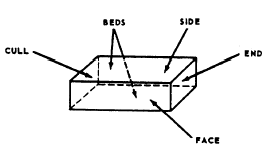|
BRICK MASONRY In brick masonry construction, units of baked clay
or shale of uniform size are laid in courses with
mortar joints to form walls of virtually unlimited
length and height. These units are small enough
to be placed with one hand. Bricks are kiln-baked
from various clay and shale mixtures. The
chemical and physical characteristics of the ingredients
vary considerably; these and the kiln temperatures
combine to produce brick in a variety
of colors and harnesses. In some regions, pits
are opened and found to yield clay or shale that,
when ground and moistened, can be formed
and baked into durable brick; in other regions,
clays or shales from several pits must be mixed.
The dimensions of a U.S. standard building brick
are 2 1/4 by 3 3/4 by 8. The actual dimensions
of brick may vary a little because of shrinkage
during burning.
Brick Nomenclature
Frequently, the Builder must cut the brick into
various shapes. The most common shapes are shown
in figure 7-50. They are called half or bat, three-quarter
closure, quarter closure, king closure,
queen closure, and split. They are used to
fill in the spaces at corners and such other places
where a full brick will not fit. The
six surfaces of a brick are called the cull, the
beds, the side, the end, and the face, as shown in
figure 7-51.
Brick Classification
A finished brick structure contains FACE brick
(brick placed on the exposed face of the structure)
and BACKUP brick (brick placed behind
the face brick). The face brick is often of higher
quality than the backup brick; however, the
entire wall may be built of COMMON brick.

Figure 7-50.-Nomenclature of common shapes of cut brick.

Figure 7-51.-Brick surfaces nomenclature.
Common brick is brick that is made from pit-run clay,
with no attempt at color control and no
special surface treatment like glazing or enameling.
Most common brick is red. Although
any surface brick is a face brick as distinguished
from a backup brick, the term face brick
is also used to distinguish high-quality brick from
brick that is of common-brick quality or less.
Applying this criterion, face brick is more uniform
in color than common brick, and it may be
obtained in a variety of colors as well. It may be
specifically finished on the surface, and in any case,
it has a better surface appearance than common
brick. It may also be more durable, as a
result of the use of select clay and other materials,
or as a result of special manufacturing methods.
|


|







